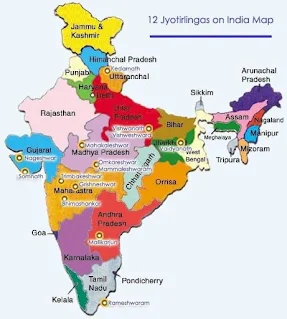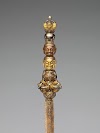 |
| Jyotirlingas are his various manifestations |
We all are aware of the 12 Jyotirlingas of Lord Shiva.These are the places where Lord Shiva resides in some form or the other protecting and blessing his devotees. Originally it was believed that there are 64 Jyotirligas but there are only 12 Jyotirlingas of Lord Shiva which are considered to be the purest/ perfect manifestations of Lord Shiva. This will be a series of 13 articles, first one being the introduction and the rest 12 about the story of each jyotirlinga.
The word Jyotirlinga is made up of two words “Jyoti” and “Linga”. ‘Jyoti’ means Light and ‘Linga’ means the representation of Shiva. Here I want to clear a point that the word Lingam has nothing to do with the union of phallus (male sex organ) and the yoni (the female sex organ), it is simply the form/symbol in which Lord Shiva is worshipped. To make things more clear here is the story which will tell you why Lord Shiva is worshipped in the form of Lingam.
 |
| When Shiva snatched away the 5th head of Brahma |
When Lord Brahma emerged from the Lotus, which emerged from the belly button of Lord Vishnu, he started the process of creation. He began with the creation of the sun, the planets, stars and created everything that we see in today’s world. Lord Shiva decided to see the creation done by Brahma. But when he saw the world, he was aghast to see the misery, unhappiness, frustration, sadness and what not. He became so sad that he began to cry. His tears fell on the earth and from them emerged the Rudraksh beads. As his anger grew whilst watching the world which was inflicted with pain, agony,disease etc, he took his fierce from, the Bhairav. He went to Brahma Lok and confronted Brahma. But Brahma was so proud of himself that he was in no mood to listen to Lord Shiva. Seeing Brahma ignoring his words made Lord Bhairav more infuriated. Therefore in order to break Brahma’s ego, Lord Bhairav with his huge sword like nails snatched the fifth head of Brahma. Brahma cried in pain and cursed Shiva that he will never be worshipped in his human form but in the form of a Lingam.
Since Lord Shiva and goddess Adi Parashakti, also known as Adishakti are the supreme representation of the union of the Purusha and the Prakriti(the Ardhanareshwar form of Lord shiva) it has been wrongly interpreted to represent the union of the sex organs of the male and the female.
Jyotirlinga is the devotional representation of shiva, the supreme God. The Jyotirlinga is believed to contain the soul of Lord Shiva himself.There is a shloka which recites the names of all the 12 jyotirlingas. It is known as the Dwadash Jyotirlinga Strotam.( द्वादश ज्योतिर्लिंग स्तोत्रम्). It describes the 12 Jyotirlingas as follows:
द्वादश ज्योतिर्लिंग स्तोत्रम्
सौराष्ट्रे सोमनाथं च श्रीशैले मल्लिकार्जुनम्।
उज्जयिन्यां महाकालमोङ्कारममलेश्वरम्॥
परल्यां वैद्यनाथं च डाकिन्यां भीमशङ्करम्।
परल्यां वैद्यनाथं च डाकिन्यां भीमशङ्करम्।
सेतुबन्धे तु रामेशं नागेशं दारुकावने॥
वाराणस्यां तु विश्वेशं त्र्यम्बकं गौतमीतटे।
वाराणस्यां तु विश्वेशं त्र्यम्बकं गौतमीतटे।
हिमालये तु केदारं घुश्मेशं च शिवालये॥
एतानि ज्योतिर्लिङ्गानि सायं प्रातः पठेन्नरः।
एतानि ज्योतिर्लिङ्गानि सायं प्रातः पठेन्नरः।
सप्तजन्मकृतं पापं स्मरणेन विनश्यति॥
एतेशां दर्शनादेव पातकं नैव तिष्ठति।
एतेशां दर्शनादेव पातकं नैव तिष्ठति।
कर्मक्षयो भवेत्तस्य यस्य तुष्टो महेश्वराः॥:
English Translation(Literal) of the Strotam:
Somanath in Saurashtra and Mallikarjunam in Shri-Shailam. (सौराष्ट्रे सोमनाथं च श्रीशैले मल्लिकार्जुनम्).
Mahakaal in Ujjain and Amleshwar in Omkareshwar. (उज्जयिन्यां महाकालमोङ्कारममलेश्वरम्).
Vaidyanath in Paralya and Bhimashankaram in Dakniya. (परल्यां वैद्यनाथं च डाकिन्यां भीमशङ्करम्).
Rameshem (Rameshwaram) in Sethubandh andNageshem (Nageshwar) in Darauka-Vana. (सेतुबन्धे तु रामेशं नागेशं दारुकावने).
Vishwa-Isham (Vishvanath) in Vanarasi and Triambakam at bank of Gautami River. (वाराणस्यां तु विश्वेशं त्र्यम्बकं गौतमीतट).
Kedar (Kedarnath) in Himalayas and Gushmesh (Gushmeshwar) in Shivalaya (Shiwar). (। हिमालये तु केदारं घुश्मेशं च शिवालये).
One who recites these Jyotirlingas every evening and morning. (एतानि ज्योतिर्लिङ्गानि सायं प्रातः पठेन्नरः।).
He is relieved of all sins committed in past seven lives.(सप्तजन्मकृतं पापं स्मरणेन विनश्यति)
One who visits these, gets all his wishes fulfilled (एतेशां दर्शनादेव पातकं नैव तिष्ठति)
and one’s karma gets eliminated as Maheshwara gets satisfied to the worship:(कर्मक्षयो भवेत्तस्य यस्य तुष्टो महेश्वराः)
Somanath in Saurashtra and Mallikarjunam in Shri-Shailam. (सौराष्ट्रे सोमनाथं च श्रीशैले मल्लिकार्जुनम्).
Mahakaal in Ujjain and Amleshwar in Omkareshwar. (उज्जयिन्यां महाकालमोङ्कारममलेश्वरम्).
Vaidyanath in Paralya and Bhimashankaram in Dakniya. (परल्यां वैद्यनाथं च डाकिन्यां भीमशङ्करम्).
Rameshem (Rameshwaram) in Sethubandh andNageshem (Nageshwar) in Darauka-Vana. (सेतुबन्धे तु रामेशं नागेशं दारुकावने).
Vishwa-Isham (Vishvanath) in Vanarasi and Triambakam at bank of Gautami River. (वाराणस्यां तु विश्वेशं त्र्यम्बकं गौतमीतट).
Kedar (Kedarnath) in Himalayas and Gushmesh (Gushmeshwar) in Shivalaya (Shiwar). (। हिमालये तु केदारं घुश्मेशं च शिवालये).
One who recites these Jyotirlingas every evening and morning. (एतानि ज्योतिर्लिङ्गानि सायं प्रातः पठेन्नरः।).
He is relieved of all sins committed in past seven lives.(सप्तजन्मकृतं पापं स्मरणेन विनश्यति)
One who visits these, gets all his wishes fulfilled (एतेशां दर्शनादेव पातकं नैव तिष्ठति)
and one’s karma gets eliminated as Maheshwara gets satisfied to the worship:(कर्मक्षयो भवेत्तस्य यस्य तुष्टो महेश्वराः)
 |
| Locations of Various Jyotirlingas in India |
The list of the 12 Jyotirlingas are as follows:
1. Somnath Jyotirlinga, Gujarat.
2. Mallikarjuna Jyotirlinga, Andhra Pradesh.
3. Mahakaleshwar Jyotirlinga, Madhya Pradesh.
4. Omkareshwar Jyotirlinga, Madhya Pradesh.
5. Baidyanath Jyotirlinga, Jharkhand.
6. Bhimashankar Jyotirlinga, Maharashtra.
7. Rameshwaram Jyotirlinga, Tamil Nadu.
8. Nageshwar Jyotirlinga, Gujarat.
9. Kashi Vishwanath Jyotirlinga, Varanasi.
10. Trimbakeshwar Jyotirlinga, Nasik.
11. Kedarnath Jyotirlinga, Uttarakhand.
12. Ghrishneshwar Jyotirlinga, Aurangabad.
Like and Follow us on Facebook "Spirituality Talks By Kabir".











0 Comments
Namaste Dear readers,
We always appreciate your feedback regarding our articles on Spirituality Talks By Kabir. We will try to reply to your queries as soon as possible. Here is our humble request to our readers:
1. Make sure you subscribe to our email delivery so that you do not miss reading any of our articles. To subscribe click on "subscribe" button below the header and follow the steps.
2. Please do not spam.Spam comments will be deleted immediately on our review.
3. Please do not add links to the body of your comments as they will not be published. In some exceptions you can contact us and we can add your link in our posts.
4. Only English comments shall be approved. Please comment in English so that everyone can understand them.
5. If you have a query/problem, first check all the comments. Maybe someone else already had posted your query.
Thank you for taking time to read our articles. We really appreciate you visiting and hope for your revisit.